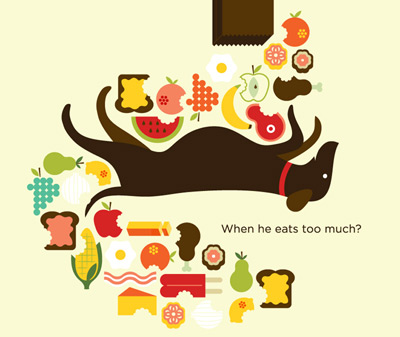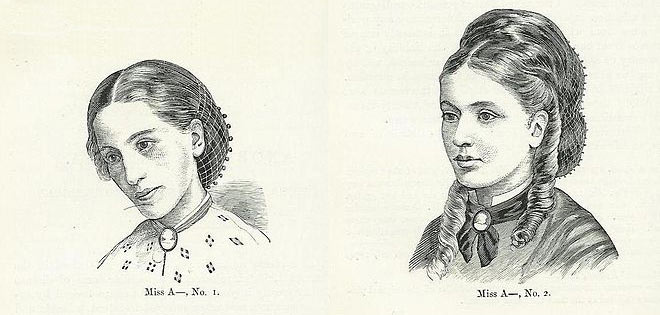health

A team of Argentine scientists, led by Conrado Avendano of the Nascentis Center for Reproductive Medicine in Cordoba, found that placing drops of semen from healthy men under a laptop connected wirelessly to the Internet maims or even kills the sperm cells.
After four hours underneath the WiFi-connected computer, 25% of the sperm had stopped moving and nine percent showed DNA damage. By comparison, semen kept at the same temperature but away from the computer showed just a 14% drop in mobility and only 3% suffered DNA damage.
{ United Academics | Continue reading }
artwork { Katsushika Hokusai }
related { How the world’s engineers built Wi-Fi }
health, technology | November 30th, 2011 9:02 am

For a long time it has been said that children born in different seasons are more or less susceptible to certain illnesses. (…)
A wealth of data shows that your month of birth has very small but noticeable difference in your long term outcome. For example, spring babies end up growing to be a quarter of an inch (0.6 cm) taller than autumn babies.
Some medical conditions also show a fairly strong relationship to birth month. Schizophrenia is uncommon but the risk is increased 10% if you are born in the dark months (winter to early spring). For Multiple Sclerosis, May is a particularly bad month to be born (or November in the Southern hemisphere).
{ Doctor Stu’s Blog | Continue reading }
painting { Herbert James Draper, Halcyone, 1915 }
health | November 18th, 2011 1:11 pm

1. High heels can lead to heel and ankle pain. (…)
2. High heels alter the electrical activity in your lower back muscles. (…)
3. High heels can shorten your muscle fibers and thicken your tendons. Last year, scientists in Austria reported on their findings on women who, perhaps counter-intuitively, feel pain when walking flat-footed. These women were habitual heel-wearers, and ultrasounds revealed their calf muscle fibers to be 13% shorter than those of women who wear flat shoes. (…)
4. High heels can lead to joint degeneration and osteoarthritis of the knee. (…)
5. High heels can lead to calluses, bunions, and hammertoes.
{ Try Nerdy | Continue reading }
fashion, guide, health | November 18th, 2011 1:00 pm

Dental health has a major effect on the overall health of an individual. A new study from the American Journal of Physical Anthropology assesses the association of dental health with other pathology on the skeleton. A number of modern studies have correlated dental diseases with other infections and pathologies, finding that individuals with poor oral health have a higher risk of mortality.
{ Bones don’t lie | Continue reading }
photo { John Vachon, Advertising, Woodbine, Iowa, 1940 }
health | November 15th, 2011 4:05 pm

A new study, published in the Journal of Sexual Medicine, suggests there’s a link between bestiality and penile cancer.
During the research, led by urologist Stenio de Cassio Zequi, 492 men from rural Brazil were examined. 118 of these men had been diagnosed with penile cancer. 45 percent of the group that suffered from penile cancer had sexual relations with animals.
Of those men who had sexual relations with animals, 59 percent reported having sex with animals for one to five years and 21 percent had been doing it for more than five years. Sexual interaction occurred as often as daily and included animals such as horses, cows, pigs, and chickens.
{ United Academics | Continue reading }
health, zoophilia | November 11th, 2011 11:25 am

Men and women are what is termed sexually dysmorphic in terms of finger lengths. In women, the index and ring fingers are generally the same length, while in men the index finger is generally shorter.
Researchers from UC Berkeley created a stir in 2000 when they reported that lesbian women tended to have a ratio of the two finger lengths that was more typical of men. But the situation was more complicated for men. The team found no difference in the ratio between gay and straight men unless they had several older brothers — a factor which had previously been linked to being homosexual. Such men were found to have an unusually low ratio of the finger lengths.
Other recent research has suggested that men with a lower ratio have a more symmetrical face and are more attractive to women, a phenomenon known as the “sexy ratio.”
{ LA Times | Continue reading }
The longer a man’s ring finger when compared with his index finger, the longer the length of his penis, according to Korean researchers.
{ ABC | Continue reading }
The length of a man’s fingers can provide clues to his risk of prostate cancer, according to new research.
{ BBC | Continue reading }
The length of a man’s fourth finger has been linked to his libido.
{ Daily Mail | Continue reading }
Men with longer ring fingers more likely to be rich.
{ Telegraph | Continue reading }
photo { Erica Segovia }
genders, health, science | November 10th, 2011 9:32 am

What’s the deal with witches and broomsticks? (…)
Harner notes that since antiquity many hallucinogenic plants have been known throughout the world, including some species of the potato family such as jimsonweed, devil’s-weed, mad apple, etc., as well as potato cousins like mandrake, henbane, and belladonna.
Trolling through the works of medieval and Renaissance writers, Harner finds a number of instances in which witchy hallucinations follow a potent hit of drugs. How were these drugs administered? Typically in the form of an ointment. Where was this ointment applied? To the skin, of course, but more effectively to the mucous membranes. Where can one find mucous membranes? In the vagina, among other places. How would one apply ointment to one’s vagina? Well, one can always count on one’s fingers, I suppose. But you could also use, uh, a pole. And where might one find a pole in the average peasant household? A broomstick.
Harner buttresses his thesis with some choice quotes. From a witchcraft investigation in 1324: “In rifleing the closet of the ladie, they found a Pipe of oyntment, wherewith she greased a staffe, upon the which she ambled and galloped through thick and thin.” Also this from around 1470: “But the vulgar believe, and the witches confess, that on certain days or nights they anoint a staff and ride on it to the appointed place or anoint themselves under the arms and in other hairy places.”
{ The Straight Dope | Continue reading }
drugs, flashback, weirdos | November 6th, 2011 9:08 am

By consuming fewer calories, aging can be slowed down and the development of age-related diseases such as cancer and type 2 diabetes can be delayed. The earlier calorie intake is reduced, the greater the effect.
Researchers at the University of Gothenburg have now identified one of the enzymes that hold the key to the aging process.
{ EurekAlert | Continue reading }
related { She was found dead that afternoon; poisoned by water. From salami to soda pop: what does “toxic” really mean?
Botany, food, drinks, restaurants, health | October 31st, 2011 2:00 pm

The growing part of the nail is the part still under the skin at the nail’s proximal end under the epidermis, which is the only living part of a nail.
In mammals, the length and growth rate of nails is related to the length of the terminal phalanges (outermost finger bones). Thus, in humans, the nail of the index finger grows faster than that of the little finger; and fingernails grow up to four times faster than toenails.
In humans, nails grow at an average rate of 3 mm (0.12 in) a month (as they are a form of hair). Fingernails require 3 to 6 months to regrow completely, and toenails require 12 to 18 months. Actual growth rate is dependent upon age, gender, season, exercise level, diet, and hereditary factors. Nails grow faster in the summer than in any other season.
Contrary to popular belief, nails do not continue to grow after death.
{ Wikipedia | Continue reading }
health | October 30th, 2011 2:46 pm

A University of Maastricht study found that eating at least four small meals daily reduces obesity risk by 45 percent. This Dutch study also found that people who skip breakfast are five times as likely to become obese as regular breakfasters.
Yet a University of Ottawa study found that eating many small meals doesn’t promote weight loss. So did a French National Center for Scientific Research study, which trashed grazing: “Epidemiological studies which have suggested that nibbling is associated with leanness are extremely vulnerable to methodological errors,” its authors warn.
A UC Berkeley study found that “alternate-day fasting” — feasting one day, fasting the next, ad infinitum — might decrease the risk of heart disease and cancer.
Researching the effects of meal frequency is notoriously tricky, because it involves so many variables: nutritional content, time of day, exercise, genetics. So the scientific jury is still out.
“There is no biological reason for eating three meals a day,” says Yale University history professor Paul Freedman.
{ AlterNet | Continue reading }
photo { Rasmus Mogensen }
food, drinks, restaurants, health, science | October 27th, 2011 11:32 am

By the 1980s, the onset of puberty, if not actual menstruation, had gone into free fall–a change so sudden and pronounced that something more than normal evolution must have been at work. In a landmark 1997 study of 17,000 [US] girls, more than 10% of white girls and an astonishing 37.8% of black girls were showing early breast development by age 8. (…)
Later studies, one in 1998 and another in 2010, included Hispanics and produced similar results. On average, 2 out of every 10 white girls, 3 out of 10 Latinas and 4 out of 10 black girls are showing breast development by age 8.
Obesity, a well-established puberty accelerant, is high on the list of suspects.
{ Time via Overcoming Bias | Continue reading }
photo { Mustafah Abdulaziz }
U.S., health, kids | October 26th, 2011 1:20 pm

Kings, queens and dukes were always richer and more powerful than the population at large, and would surely have liked to use their money and power to lengthen their lives, but before 1750 they had no effective way of doing so. Why did that change? While we have no way of being sure, the best guess is that, perhaps starting as early as the 16th century, but accumulating over time, there was a series of practical improvements and innovations in health. (…)
The children of the royal family were the first to be inoculated against smallpox (after a pilot experiment on condemned prisoners), and Johansson notes that “medical expertise was highly priced, and many of the procedures prescribed were unaffordable even to the town-dwelling middle-income families in environments that exposed them to endemic and epidemic disease.” So the new knowledge and practices were adopted first by the better-off—just as today where it was the better-off and better-educated who first gave up smoking and adopted breast cancer screening. Later, these first innovations became cheaper, and together with other gifts of the Enlightenment, the beginnings of city planning and improvement, the beginnings of public health campaigns (e.g. against gin), and the first public hospitals and dispensaries, they contributed to the more general increase in life chances that began to be visible from the middle of the 19th century.
Why is this important? The absence of a gradient before 1750 shows that there is no general health benefit from status in and of itself, and that power and money are useless against the force of mortality without weapons to fight. (…)
Men die at higher rates than women at all ages after conception. Although women around the world report higher morbidity than men, their mortality rates are usually around half of those of men. The evidence, at least from the US, suggests that women experience similar suffering from similar conditions, but have higher prevalence of conditions with higher morbidity, and lower prevalence of conditions with higher mortality so that, put crudely, women get sick and men get dead.
{ Angus Deaton, Center for Health and Wellbeing, Princeton University | Continue reading | PDF }
artwork { Willem de Kooning, Queen of Hearts, 1943-46 }
flashback, health, ideas | October 14th, 2011 1:08 pm

{ “Miss A—” pictured in 1866 and in 1870 after treatment. She was one of the earliest Anorexia nervosa case studies. The term anorexia nervosa was established in 1873 by Sir William Gull, one of Queen Victoria’s personal physicians. The term is of Greek origin: an- (prefix denoting negation) and orexis (appetite). | Wikipedia | Continue reading }
Linguistics, food, drinks, restaurants, health | September 21st, 2011 5:47 pm

Both correlational and experimental evidence suggest that when people are sleep deprived, they feel more irritable, angry and hostile. Sleep loss is also associated with greater depressive mood. In addition, sleep deprivation seems to be associated with greater reactivity in that people who suffer from sleep loss are especially likely to react negatively when something doesn’t go well for them. For those of you interested in the brain – some research suggests that sleep deprivation enhances negative mood due to increased amygdale activity (a brain structure integral to experiences of negative emotions such as anger and rage) and a disconnect between the amygdale and the area of the brain that regulates its functions. In other words: increased negative mood, and decreased ability to regulate that anger.
{ Psych Your Mind | Continue reading }
brain, sleep | September 20th, 2011 8:09 am

In December 2010, two independent laboratories have demonstrated that a full genome-wide analysis of the fetus could be performed from a sample of maternal blood, making fetal diagnostic testing possible in the future for any known genetic condition. The convergence of cffDNA (cell-free fetal DNA) testing with low cost genomic sequencing will enable prospective parents to have relatively inexpensive access to a wide range of genetic information about their fetus from as early as seven weeks gestation.
This article examines a range of ethical, legal and social implications associated with introducing NIPD (non-invasive prenatal diagnosis) into prenatal practice.
{ SSRN | Continue reading }
genes, health, kids | September 20th, 2011 8:05 am

{ Domestic cats have been genetically modified to resist the feline form of AIDS in a new study that could have significant implications for health researchers working to protect humans from the virus. | Cosmos | Smithsonian }
related { Missing Colorado cat found in New York }
cats, health, science | September 16th, 2011 9:55 am

A year ago, when chemotherapy stopped working against his leukemia, William Ludwig signed up to be the first patient treated in a bold experiment at the University of Pennsylvania.
Doctors removed a billion of his T-cells — a type of white blood cell that fights viruses and tumors — and gave them new genes that would program the cells to attack his cancer. Then the altered cells were dripped back into Mr. Ludwig’s veins.
At first, nothing happened. But after 10 days, hell broke loose in his hospital room. He began shaking with chills. His temperature shot up. His blood pressure shot down. He became so ill that doctors moved him into intensive care and warned that he might die. His family gathered at the hospital, fearing the worst.
A few weeks later, the fevers were gone. And so was the leukemia.
There was no trace of it anywhere — no leukemic cells in his blood or bone marrow, no more bulging lymph nodes on his CT scan. His doctors calculated that the treatment had killed off two pounds of cancer cells.
A year later, Mr. Ludwig is still in complete remission. Before, there were days when he could barely get out of bed; now, he plays golf and does yard work.
Mr. Ludwig’s doctors have not claimed that he is cured — it is too soon to tell — nor have they declared victory over leukemia on the basis of this experiment, which involved only three patients. The research, they say, has far to go; the treatment is still experimental, not available outside of studies.
But scientists say the treatment that helped Mr. Ludwig may signify a turning point in the long struggle to develop effective gene therapies against cancer. And not just for leukemia patients: other cancers may also be vulnerable to this novel approach — which employs a disabled form of H.I.V.-1, the virus that causes AIDS, to carry cancer-fighting genes into the patients’ T-cells. In essence, the team is using gene therapy to accomplish something that researchers have hoped to do for decades: train a person’s own immune system to kill cancer cells.
{ NY Times | Continue reading }
health | September 14th, 2011 8:06 am

How does inheritance of blood types work?
There are three blood genes: A, B, and O. (I’m going to ignore the + and - part of this.) A and B are dominant, and O is recessive. You inherit one blood gene from your mother and one from your father. The combination of genes determines your blood type. There are four possibilities: A, B, AB, and O. Here’s how it works:
A + A = A
A + O = A
A + B = AB
B + B = B
B + O = B
O + O = O
{ The Straight Dope | Continue reading }
The Rh (Rhesus) blood group system (including the Rh factor) is one of the currently 30 human blood group systems. It is clinically the most important blood group system after ABO. The Rh blood group system currently consists of 50 defined blood-group antigens, among which the 5 antigens D, C, c, E, and e are the most important ones. The commonly-used terms Rh factor, Rh positive and Rh negative refer to the D antigen only.
An individual either has, or does not have, the “Rhesus factor” on the surface of their red blood cells. This term strictly refers only to the most immunogenic D antigen of the Rh blood group system, or the Rh- blood group system. The status is usually indicated by Rh positive (Rh+, does have the D antigen) or Rh negative (Rh-, does not have the D antigen) suffix to the ABO blood type.
{ Wikipedia | Continue reading }
blood | September 12th, 2011 3:25 pm

I’m going to tell you a little story about a menstruating nurse.
Dr. Bela Schick, a doctor in the 1920s, was a very popular doctor and received flowers from his patients all the time. One day he received one of his usual bouquets from a patient. The way the story goes, he asked one of his nurses to put the bouquet in some water. The nurse politely declined. Dr. Schick asked the nurse again, and again she refused to handle the flowers. When Dr. Schick questioned his nurse why she would not put the flowers in water, she explained that she had her period. When he asked why that mattered, she confessed that when she menstruated, she made flowers wilt at her touch.
Dr. Schick decided to run a test. Gently place flowers in water on the one hand… and have a menstruating woman roughly handle another bunch in order to really get her dirty hands on them.
The flowers that were not handled thrived, while the flowers that were handled by a menstruating woman wilted.
This was the beginning of the study of the menstrual toxin, or menotoxin, a substance secreted in the sweat of menstruating women.
{ Scientific American | Continue reading }
photo { Andres Marroquin Winkelmann }
Botany, blood, science | September 10th, 2011 7:32 pm

Regular and moderate alcohol consumption in working middle-aged women has been found to improve their health by helping them to ‘wind down’.
The new study, published in PLoS Medicine today, analysed data from the U.S. Nurse’s Health Study, a long-term study that has tracked the health conditions of 121,700 female nurses since 1976. (…)
The researchers found that those middle-aged women (median age 58 years) who drank five to 15 grams of alcohol per day were 20% more likely to have good overall health when older, in comparison to non-drinkers.
{ Cosmos | Continue reading }
food, drinks, restaurants, health, science | September 9th, 2011 2:38 pm






















